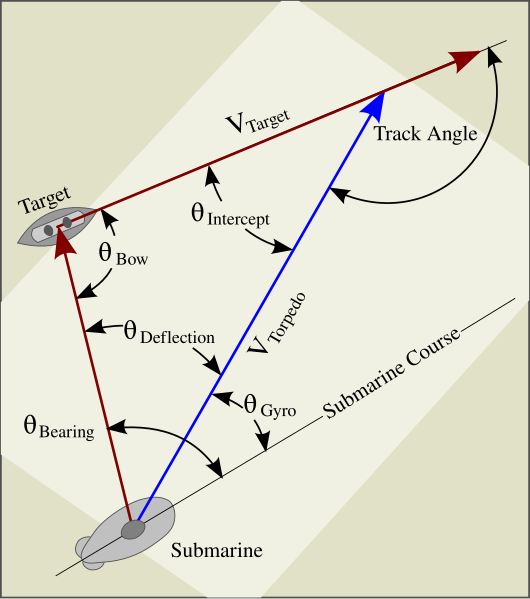Much of this is based on already knowing the enemy course and speed, which, of course, is what you are trying to find out. Circular reasoning finds nothing.
What good is linear distance per degree when we don't know the range? We take a great numbers table and reduce it to speculation. How to we obtain an AoB of 10º? Is it just because the bearing is 80º? Now 80º to the left of zero is 360-80=280º not 260º. It's entirely unclear what your arithmetic gymnastics are all about there. Maybe you're talking about taking a stern shot (180º plus or minus relative bearing from astern) or maybe not. You don't say.
And because you don't say, your method isn't clear at all and your instructions can't be followed. What is the purpose of targeting instruction? Please try again.
Especially you must get over the hurdle of proving that if a target bears 80º its AoB must be 10º. That's a real groaner.
Finally, if you have a sub with radar, what's the purpose of all these calculations? Wouldn't a graphical method be more appropriate and self-checking for error mitigation purposes? See my flash card for the Vector Analysis Targeting Method in the Bag of Tricks thread for an example of how you might proceed.
The purpose of instructions is to make crystal clear the simplest method to accomplish a task, so that the vast majority of those with the instructions can successfully follow them to the goal. Your post is far short of that standard, even for expert players.
Oh, the game only works in full degrees. Therefore a ship at bearing 15.4 is called at 15º, a ship bearing 15.6 is called at 16º giving your bearing method an error envelope of plus or minus 50 or 60% of a degree--certainly not accurate enough to do ANY targeting with no matter how good you are with the sonar. And the kicker is that we really don't know what their rounding system is so the error is actually entirely unquantifiable but very significant.
Basic error mitigation techniques mean that you must estimate expected error and they tailor your method so that errors of that magnitude still result in a BOOM at the end of the procedure. There's no evidence of ANY error mitigation analysis in your method anywhere, and no, it is NOT the method taught in the Submarine Torpedo Fire Control manual.
And forcing Sun Tsu in there is just irrelevantly irritating. He's not applicable.
I say the game changer in WWII fleet boats was radar. Use the thing all the time. Get radar ranges: the gold standard. Get radar bearings: the gold standard. Get course by radar before you ever sight the target: more accurate at 20,000 yards than a stadimeter at 1500 yards. Calculate speed by number of yards traveled in three minutes divided by 100, easily done in your head and accurate to much less than a knot. The game rounds all speeds to the nearest knot too, so everything goes to the nearest knot, nearest degree, nearest yard (or maybe nearest meter, converted to yards, rounded by unknown method to nearest yard), rounding methods throughout, unknown. So in all cases the most accurate measurement you have by far is radar. The stealthiest method you have is radar, even if the signal is detected they know you're out there, you know everything about them. Radar is also the easiest method to implement, least error prone, simplest calculations (most calculations are totally unnecessary, being solved in graphical form on the nav map.)
Looked you up, greyrider. That's who I thought you were. Folks, the 80-10 method is a fallacy. It can't be even put into understandable words because it is based on a simple fallacy that if the bearing to target is 80º its AoB MUST be 10º. That is patently false so the method fails completely. Graphs to prove upon request and I'll make a follow-up post in the Bag of Tricks thread so no one is tempted to waste their time trying to figure out this method, which is no method at all.
As a matter of fact, Aktungbby has a graph below where the bearing to target is just about 80º port by German reckoning, 280º by American reckoning. However, the AoB, shown as theta bow on the graph is in the neighborhood of 110º starboard. 80-10 dies horribly, failing on its very first claim. In fact, angle on the bow has no relationship at all to the target's bearing from the submarine.

